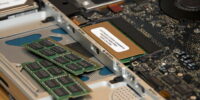What Is Overclocking: Boosting Performance Of Pc Components
Overclocking, the process of increasing the clock speed of computer components beyond their factory settings, has become a popular technique to boost performance and enhance overall system capabilities.
By altering the frequency at which a central processing unit (CPU), graphics processing unit (GPU), or random access memory (RAM) operates, overclocking aims to extract additional computational power from these components.
This article delves into the fundamentals of CPU speed and explores the benefits of overclocking. It also provides insights into selecting appropriate hardware for overclocking and offers step-by-step guides on how to overclock CPUs, GPUs, and RAMs.
Additionally, it discusses crucial aspects such as managing temperature and cooling for overclocked components, as well as monitoring and testing stability.
By understanding the intricacies of overclocking, readers will be equipped with knowledge to optimize their PC’s performance effectively while considering potential risks and limitations associated with this practice.
Key Takeaways
- Overclocking is the process of increasing the clock speed of computer components to boost performance and enhance system capabilities.
- It involves altering the frequency at which a CPU, GPU, or RAM operates to extract additional computational power.
- Overclocking offers benefits such as faster processing speeds, improved multitasking capabilities, reduced loading times, and faster data transfers.
- Careful hardware selection, monitoring of temperature and voltage, stress testing, and stability testing are crucial for successful and reliable overclocking.
Understanding the Basics of CPU Speed
The understanding of CPU speed is crucial in the realm of overclocking, as it serves as a foundation for boosting the performance of PC components.
CPU speed refers to how fast the central processing unit (CPU) can execute instructions per second. It is measured in hertz (Hz) and commonly expressed in gigahertz (GHz).
The CPU speed determines how quickly data can be processed, which directly impacts the overall performance of a computer system.
Overclocking involves increasing the clock speed of a CPU beyond its default settings to achieve higher performance levels. This process requires adjusting voltage and other settings to ensure stability and prevent overheating.
However, it should be approached with caution, as excessive overclocking can lead to system instability or even permanent damage to computer components if not done properly.
Exploring the Benefits of Overclocking
One advantage of increasing the speed of computer parts beyond their default settings is the potential for enhanced functionality and improved overall user experience. Overclocking, a technique used to achieve this, offers several benefits.
Firstly, it allows users to extract more performance from their existing components without the need for expensive upgrades. This can result in faster processing speeds and smoother multitasking capabilities, especially when performing resource-intensive tasks such as gaming or video editing.
Secondly, overclocking can lead to reduced loading times and faster data transfers, enhancing system responsiveness.
Additionally, overclocking can provide a competitive edge in gaming by enabling higher frame rates and smoother gameplay. However, it is important to note that overclocking may also increase power consumption and heat production, which could potentially shorten the lifespan of components if not properly managed through adequate cooling solutions.
Selecting the Right Hardware for Overclocking
To optimize the potential of enhancing speed beyond default settings, careful consideration must be given to selecting the appropriate hardware for achieving overclocking goals.
When choosing hardware for overclocking, there are three key factors to consider:
-
Quality of components: Opting for high-quality components is crucial as they can handle increased voltage and heat generated during overclocking without compromising stability or longevity.
-
Cooling solutions: Investing in efficient cooling solutions such as liquid cooling or high-performance air coolers is essential. These help dissipate the extra heat generated by overclocked components, preventing thermal throttling and ensuring optimal performance.
-
Power supply unit (PSU): A reliable PSU with sufficient wattage is necessary to provide stable power delivery to all components during intense overclocking sessions. Insufficient power supply can lead to instability and system crashes.
By carefully selecting hardware that fulfills these criteria, users can maximize their chances of successfully achieving their desired performance enhancements through overclocking.
Overclocking Your CPU: Step-by-Step Guide
When aiming to enhance the speed of your CPU beyond its default settings, following a step-by-step guide can help you achieve optimal results.
Overclocking your CPU involves adjusting its clock speed and voltage settings to increase performance.
Before starting the process, it is essential to ensure that your CPU is capable of being overclocked and that you have adequate cooling solutions in place.
The first step is to enter the BIOS or UEFI firmware settings by pressing a specific key during startup. Once inside, you will need to locate the options related to CPU frequency and voltage control.
It is recommended to make small adjustments gradually and stress test the system after each change for stability.
Finally, monitor the temperature of your CPU during overclocking to prevent overheating and potential damage.
Overclocking Your GPU: Maximizing Graphics Performance
Maximizing the graphics capabilities of your GPU involves optimizing its settings to push its limits and unlock its full potential. Overclocking your GPU is a method used to increase its clock speed, allowing it to perform at higher frequencies than the manufacturer’s specifications.
This process aims to enhance graphical performance by boosting frame rates and improving overall visual quality. To overclock your GPU, you need specialized software that allows you to adjust various parameters such as core clock, memory clock, and voltage.
However, it is crucial to proceed with caution as improper settings can lead to instability, overheating, or even permanent damage to the GPU. Before starting the overclocking process, it is recommended to research your specific GPU model and understand its limitations.
Additionally, monitoring tools should be utilized during overclocking sessions to keep track of temperature and stability. By following these steps carefully, users can maximize their graphics performance and elevate their gaming or multimedia experiences.
Overclocking RAM: Enhancing System Memory
Overclocking Your GPU can significantly improve graphics performance, but it’s not the only component that can benefit from this technique.
Another crucial element to consider is the system memory, or RAM. Overclocking RAM involves increasing its frequency and adjusting timings to enhance overall system performance. By doing so, data transfer rates can be increased, leading to improved responsiveness and faster loading times for applications and games.
However, it is important to note that overclocking RAM may not yield as significant performance gains as overclocking a GPU. Additionally, it requires careful attention to stability and temperature management, as excessive overclocking could lead to system instability or even hardware damage.
Therefore, proper research and understanding of the specific RAM module’s capabilities are essential before attempting any overclocking endeavors.
Managing Temperature and Cooling for Overclocking
Efficient management of temperature and cooling is crucial for maintaining stability and safeguarding the hardware during the process of enhancing system performance. Overclocking increases the power consumption and heat generation of PC components, which can lead to thermal throttling, reduced lifespan, and even permanent damage if not properly managed. To prevent overheating, various cooling techniques are employed such as air cooling, liquid cooling, or a combination of both. Air cooling involves using fans to dissipate heat from the CPU and other components, while liquid cooling utilizes a pump to circulate coolant through tubes connected to a radiator. An effective cooling solution requires careful consideration of factors like airflow design, fan placement, radiator size, and proper application of thermal paste. Additionally, monitoring software can be used to track temperature levels and adjust fan speeds accordingly.
| Cooling Technique | Pros | Cons |
|---|---|---|
| Air Cooling | Cost-effective; Easy installation | Limited heat dissipation capability |
| Liquid Cooling | Excellent heat dissipation; Low noise level | Expensive; Complex installation process |
| Combination (Air + Liquid) Cooling | Optimal balance between cost and performance | Increased complexity compared to air cooling alone |
Table: Pros and Cons of Different Cooling Techniques | Air Cooling | Cost-effective; Easy installation process | Limited heat dissipation; Higher noise level compared to liquid cooling |
Monitoring and Testing Stability of Overclocked Components
Monitoring and testing the stability of overclocked hardware is a critical step in ensuring the reliability and functionality of enhanced system performance. By subjecting the components to rigorous monitoring, any potential issues or instability can be identified early on, preventing system crashes or damage. This process involves continuously tracking various parameters such as temperature, voltage, and clock speed to ensure they remain within safe limits.
To effectively monitor and test the stability of overclocked components, several techniques and tools are employed:
-
Stress Testing: This involves running intensive programs or benchmarks that push the components to their maximum capabilities for an extended period.
-
Real-Time Monitoring Software: Specialized software allows users to monitor key metrics in real-time while overclocking, enabling them to make adjustments accordingly.
-
System Logs: Analyzing system logs provides valuable information about any errors or inconsistencies that may occur during overclocking.
-
Benchmarking Tools: These tools measure system performance by comparing it with standardized tests, helping identify any degradation caused by overclocking.
-
Stability Testing Utilities: Utilizing specific programs designed to stress-test different aspects of hardware ensures its stability under extreme conditions.
By utilizing these monitoring and testing methods, users can determine if their overclocked components operate reliably without compromising long-term functionality.
Frequently Asked Questions
Can overclocking damage my computer hardware?
Yes, overclocking can potentially damage computer hardware. It increases the voltage and temperature of components, which may exceed their limits and lead to instability, reduced lifespan, or complete failure.
Will overclocking void my warranty?
Overclocking can potentially void the warranty of computer hardware, as it involves running components beyond their specified limits. Manufacturers typically do not cover damages caused by overclocking, so caution should be exercised before attempting it.
How much performance improvement can I expect from overclocking?
The performance improvement that can be expected from overclocking varies depending on the specific PC components and the extent of overclocking. However, it is generally acknowledged that overclocking can lead to noticeable improvements in processing speed and overall system performance.
Can I overclock my computer if I have a pre-built system?
Overclocking can be done on pre-built systems, but it is important to consider factors such as the system’s cooling capabilities and power supply. It is advisable to consult with the manufacturer or a professional before attempting overclocking.
How do I revert back to default settings if I encounter stability issues after overclocking?
Reverting back to default settings can resolve stability issues after overclocking. This can be achieved by accessing the BIOS/UEFI settings, locating the "Restore Defaults" option, and selecting it to reset all overclocking modifications made.





